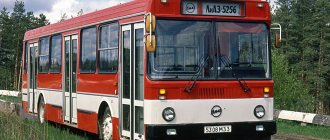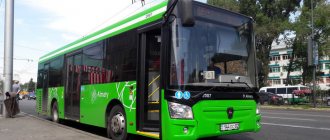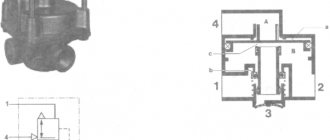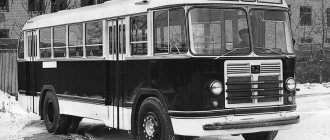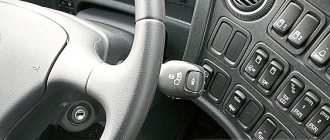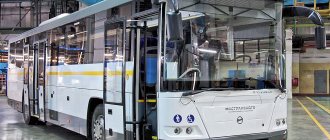LiAZ 5292 is a bestseller from the Likinsky Bus Plant. A legendary model, various modifications of which have been serving Russian cities since 2003.
The bus belongs to a large class. With a nominal capacity of about 100 people (varies depending on modifications), it is designed to work on large streets - on routes with intense passenger traffic.
Over the long years of the model’s existence, the Likinsky Plant has produced dozens of versions of the LiAZ 5292, including diesel and gas models, buses with engines from YaMZ, Caterpillar, Cummins and MAN, as well as an electric bus. First, the Likinsky plant filled the capital with its products, and then its equipment spread to other cities of Russia. LiAZ 5292 served the Winter Olympic Games in Sochi, the World Winter Universiade and many other significant events for the country.
Modern city bus
The first test model was designed, assembled and publicly demonstrated at the Moscow Automobile Salon in 2003. At that moment it was “raw” and needed improvement, since the LiAZ 5292 inherited a diesel engine and spare parts Caterpillar 3116, identical to its predecessor LiAZ-5256.25, placed transverse to the cabin, a Voith automatic transmission of the Diwa D 854.3E series, as well as a Csepel A-500.73-3520-00 steering gear.
The LiAZ 5292 engine was a 6-row engine with turbocharging and pre-cooling of turbocharged air, and had a power of 230 hp. and complied with Euro-3 standards, fuel consumption was 29 l/100 km. During the design process of the machine, some design features were missed, which as a result worsened its performance characteristics. Among them is the need to accommodate the ASCP system, which, due to the mismatch of the layout with the panel of the driver's cabin, cluttered up the free space, thereby reducing the maximum capacity, reducing the productivity, efficiency and rationality of operation of the bus. The main dimensions of the carriage-type load-bearing body (length – 11.48 m; width – 2.47 m; height – 3.00 m) have not changed since the original high-floor brand LiAZ 5256. As a result, the LiAZ-5293 model was at first a transitional “economical » option in the LiAZ low-floor equipment range.
The LiAZ 5292 bus is an urban type of transport and is widely used in megacities with an active flow of passengers. The total passenger capacity is 112 people. Of these, there are only 20 seats, including 2 seats for the disabled. The design look fully meets the requirements of modern automotive design. A low floor (the bus is raised 34 cm above the roadway surface) and a spacious passage in the doors facilitate comfortable boarding and seating for passengers, which significantly reduces the duration of travel along the route.
Tire pressure for Liaz 5292 bus
LiAZ-5256.
BUS WHEEL MAINTENANCE DAILY MAINTENANCE (EO)
Daily maintenance of bus wheels is carried out every shift.
Before leaving the line, you need to make sure that there is no air leakage from the tires during parking. If you suspect a decrease in tire pressure, you must check the pressure with a pressure gauge (see below) and, if necessary, eliminate the cause of the leak. During long stops or driver shift changes, it is necessary to inspect the tires to detect damage and obvious air leaks. Every day after the bus returns from the line, it is necessary to inspect the tires, rims and externally check the condition of the wheel fastening parts. Foreign objects lodged in the tread, sidewalls, or between dual tires must be removed. All wheel mounting parts must be in good condition, without signs of mutual displacement. If there is intensive or uneven wear of the tire tread pattern, regardless of the timing of maintenance (TO-1 or TO-2), measures should be taken to eliminate the causes of such wear.
FIRST MAINTENANCE (TO-1)
During TO-1, it is necessary to monitor the tire pressure using a pressure gauge and adjust it to the specified level. The tire pressure of all bus wheels (regardless of the location of the wheel) should be in the range of 860-880 kPa (8.6-8.8 kgf/cm2). When inflating tires, the pressure is brought to the upper limit. When the bus moves, especially in hot weather, the tire pressure increases, but it should not be reduced in heated tires. The air pressure is checked when the tires have cooled down at above-zero ambient temperatures.
A decrease in tire pressure compared to the norm leads not only to accelerated and uneven tread wear, but also to accelerated destruction of the sidewall frame, impairing the stability and controllability of the bus.
The pressure difference in the tires of dual wheels is unacceptable more than 30 kPa (0.3 kgf/cm2), as this causes uneven distribution of the load between the wheels and leads to uneven wear of the tire tread. To measure the pressure in the inner tires of dual wheels, valve extensions are installed.
WARNING. Methods for determining the air pressure in tires by inp and sound when hitting a tire are completely unacceptable, since the possible error in this case reaches 150-200 kPa (1.5-2 kgf/cm2).
When performing TO-1, the remaining tread depth is monitored and the possibility of further use of the tires is assessed.
SECOND MAINTENANCE (TO-2)
When performing TO-2, a thorough inspection of the tires is carried out and an assessment of their condition on the wheels removed from the bus is carried out. If necessary, the wheels are rearranged.
The basis for rearranging wheels may be uneven or intense wear of the tire tread pattern, the need to properly select tires for distribution on axles or dual wheels, the need to install more reliable tires on the front axle of the bus, as well as other reasons.
Source
Model performance characteristics
The technical characteristics of the updated LiAZ 5292 bus have been improved through the use of a Cummins CG-250 30 series gas engine with a power of 234 hp. at 2200 rpm. The use of gas in this area is less expensive than gasoline or diesel fuel. Plus, gas power units are environmentally cleaner than their counterparts running on petroleum products. Compressed gas (methane) is used as gas engine fuel, which is located in 6 cylinders with a capacity of 82 liters and 4 cylinders of 62 liters each on the roof or under the floor of the vehicle. The motor is placed transversely at the rear of the bus and is connected to a leading portal axle brand ZF-AV132/87/6.5 with a middle angular bevel gearbox. This feature allows it to take up little space in length, which, combined with the high-strength rear axle from Raba, provides free space for low-floor equipment.
The use of high-quality component equipment from major global manufacturers guarantees: engine life - 1,000,000 km, service life - 30,000 km, the level of lowest fuel consumption as a result of using the Topodin function in the automatic transmission is reduced to 5-15%. Technical characteristics of the LiAZ 5292 diesel engine, even in low gears, provides excellent performance, which is indicative when used for urban passenger traffic. The motor of this series fully complies with the Euro 3 toxicity class of the EEV category eco-standard, which characterizes LiAZ as the most environmentally friendly mode of transport in our country today. The volume of its harmful emissions is 2/3 less than that of the corresponding bus of the Euro 4 eco-standard. In addition, the operating power units have a reduced level of noise and vibration, which has a positive effect on the atmosphere in the cabin while driving. There are 2 accesses to the engine compartment: through the rear removable panel or directly from the interior through opening panels, which is quite convenient for inspecting and servicing the engine.
LiAZ 5292 equipment is equipped with an Allison automatic transmission of the ZF Ecolife series, the spare parts of which provide unique softness when changing gears. In addition, it is equipped with a Raba axle and a Shepel / ZF Servokom 8098 steering system. The highest speed of the bus is 80 km/h, after which acceleration stops. The wheelbase of the bus is 4x2.
The LiAZ 5292 bus has pneumatic brakes on each wheel, the front ones are Knorr-Bremse SB-7000 disc brakes, the rear ones are shoe brakes, drum type. Braking efficiency is high. The delay when pressing the brake is minimal. ABS brand Knorr-Bremse.
Table of permissible tire pressures for PAZ buses
| Model | Modifications (volume and kW) | tires | Recommended tire pressure | |||||||
| Summer without load | Summer with load | No load in winter | In winter with load | |||||||
| front | rear | front | rear | front | rear | front | rear | |||
| 3205 | 4.75 (86.2) | K-84 | 6 | 5 | 6 | 5 | 5.9 | 4.9 | 5.9 | 4.9 |
| 3205 | 4.75 (86.2) | KI-63 | 6.1 | 5 | 6.1 | 5 | 6 | 4.9 | 6 | 4.9 |
| 32053 | 4.67 (90) | K-84/U-2 | 4.6 | 4.2 | 4.6 | 4.2 | 4.5 | 4.1 | 4.5 | 4.1 |
| 32053 | 4.67 (90) | KI-111 | 5.3 | 4.5 | 5.3 | 4.5 | 5.2 | 4.4 | 5.2 | 4.4 |
| 32053 | 4.67 (90) | O-79 | 5 | 4.5 | 5 | 4.5 | 4.9 | 4.4 | 4.9 | 4.4 |
| 32053 | 4.67 (90) | VI-401 | 6 | 5.5 | 6 | 5.5 | 5.9 | 5.4 | 5.9 | 5.4 |
| 32053 | 4.67 (90) | I-397 | 6 | 5.5 | 6 | 5.5 | 5.9 | 5.4 | 5.9 | 5.4 |
| 32053 | 4.67 (90) | VL-25 | 4.7 | 4.1 | 4.7 | 4.1 | 4.6 | 4 | 4.6 | 4 |
| 3206 | 4.67 (96) | K-55A | 6 | 4.3 | 6 | 4.3 | 5.9 | 4.2 | 5.9 | 4.2 |
It should be understood that these indicators can be set by both the car manufacturer and the tire manufacturer. Depending on the brand and model of passenger transport, indicators may vary. Modern vehicles have an air pressure indicator, which makes it easier to control this indicator.
Interior arrangement
A positive feature is that the cabin is equipped with modern ventilation and air conditioning systems, which increase the level of passenger comfort during transportation. The heating system is liquid, radiator type, with a heater.
The new LiAZ 5292 is equipped with a “kniling” cabin tilt mechanism, which prevents excessive tilting of the wheelchair, which ensures comfortable transportation of passengers with obvious disabilities. In addition, there is a spacious storage area equipped with specialized fasteners that safely secure wheelchairs, as well as a ramp for convenient entry and exit from the salon.
The new LiAZ 5292 is equipped with a support body with three fairly spacious doors and voluminous storage platforms, which is a serious advantage for classic buses. The modern design of the bus is distinguished by its impressive appearance, a wide choice of exterior colors and interesting interior decoration, equipped with comfortable anti-vandal seats that allow you to sit comfortably. There are no steps in the passage of each door, the solid surface of the floor in the cabin is absolutely flat, which significantly affects not only the aesthetics and ergonomics of the bus, but also the convenience and comfort of passengers.
The driver's seat is separated from the passenger compartment by a low partition. The work chair is equipped with an air suspension with a wide range of adjustments for a comfortable position, regardless of the driver’s size. The position of the steering wheel is also adjusted and fixed by a key pneumatic locking device; the steering is equipped with a self-return mechanism. The control equipment and warning lamps on the instrument panel are located in the driver’s line of sight; the steering column and hands do not cover them. The rear view mirrors are equipped with durable brackets, which significantly reduces vibration.
If all the identified shortcomings are eliminated and the price for LiAZ turns out to be acceptable for urban consumers, this will enable large passenger carriers to form a rational urban bus network. This low-floor type of transport will be more appreciated by disabled people and pensioners, since there is no need to climb stairs.
Testing and operating tips
In the Russian Federation and CIS countries, it is customary to measure air density in kgf/cm 2, which is equal to one atmosphere. Other countries may use different physical quantities. As a rule, special instruments for checking bus tires are equipped with a practical scale.
The indicator is checked in different cases:
- if you suspect a decrease in air pressure;
- during driver shift changes;
- 100 kilometers after installation or repair of tires;
- in case of sudden frost or thaw;
- before passenger transport departs for a flight, as well as at the end of the working day;
- during long stops and maintenance.
Design
The comparison with the Geely Xingyue L was not made by chance. The Chinese model, like the presented LiAZ coupe-shaped crossover, has a body that is distinguished by sharp outlines. In addition, the elongated rear of the Russian new product hints that the car is equipped with seven seats. Producing such a long crossover with a 5-seater interior would be an unreasonable decision. Today, few people want to overpay for a car with a large trunk. This is evidenced by the fall in demand for station wagons both in Russia and abroad.
The new cross-coupe LiAZ-5292 2021-2022 is made in a style typical of many of its classmates. In addition to the sharply defined body, the car is distinguished by an almost flat roof, which slowly lowers towards the stern. But the presented new product has compact rear support struts. This is due to the fact that the window sill line closer to the stern bends sharply upward, visually increasing the size of the rear wheel fenders. The front glass of the presented new product turned out to be quite large, which, in combination with compact pillars, provides good visibility and narrows the area of “dead” zones. The fact that the domestic designer created a 7-seater crossover is supported by the presence of additional side windows located in the luggage compartment area.
At the front of the Russian new product there is a wide polygonal radiator grille with a pronounced black plastic edging. Despite the headlights recognizable from many modern SUVs, those of the LiAZ cross-coupe are distinguished by their original design: inside the head optics there are many square LEDs, some of which probably serve as DRLs.
The rounded front bumper of the Russian new product is overlapped by more than half with an elongated air intake, “emphasized” at the bottom by a characteristic protrusion. The developer placed compact fog lights on the sides, also based on LEDs.
The rear part of the body of the cross-coupe LiAZ-5292 2021-2022 is also designed in a familiar style. Here you can find a developed wing and large lights, which narrow at the edges to thin strips. The aft optics of the Russian new product are not interconnected, despite the fact that this solution is increasingly found on modern crossovers. The rear bumper is also relatively simply designed, complemented by narrow brake lights.
Technical characteristics of LiAZ-529260
Since 2014, the production of LiAZ-529260 models, low-floor buses 10.5 m long, began. The equipment is produced in two- or three-door versions. Seats – 22+1 or 26+1, total capacity – 75 passengers. Engine – YaMZ, gearbox – ZF, automatic. The car can be used on urban routes both in large cities and in small towns with limited passenger traffic.
The LiAZ-529260 modification is characterized by:
- the presence of a “kniling” tilt system;
- large storage area;
- devices for convenient transportation of passengers in wheelchairs;
- high maneuverability, thanks to which the bus can comfortably navigate narrow streets.
The main advantages of the modifications created on the basis of the LiAZ-5292 are: a comfortable interior, a well-equipped driver's seat, a long service life of the body (at least 12 years), little noise from the engine, and a low level of vibration.
Source
Gas engine versions
5292.67
Modification with a gas version of the YaMZ-536 diesel engine. Initially it was planned to assign the bus the index LiAZ-5292.90 , but in recent months the index has been renumbered. At the moment, only 1 bus of this modification has been produced and in May 2016 it began testing with passengers in Yekaterinburg. The fate of launching this modification into mass production will depend on the test results.
5292.70 (52927)
Gas modification of the LiAZ-5292.00 bus. Instead of a Caterpillar 3116 engine, a Cummins CGe 250 30 engine is installed (according to the manufacturer - MAN E0836 LOH01 (Euro-5)[2]). A total of two buses of this modification were produced. K: Wikipedia: Articles without sources (type: not specified)[ source not specified 2984 days
]. In January 2016, 5 buses arrived in Nalchik[5]. One LiAZ-52927 bus has been in use at the branch of the 11th bus depot of the State Unitary Enterprise Mosgortrans since 2006, but was written off in 2015 due to wear and tear of the equipment. The bus had a transverse Cummins CGe250 engine and a Voith automatic transmission with bevel gear. Due to the poor location of the cooling system radiator, the engine began to heat up as soon as the bus speed exceeded 30 km/h. The bus was used only in the winter season and was written off with a mileage of less than 200 thousand km.
5292.71 (52927 EEV)
Modification with a MAN E0836 LOH01 gas engine that meets EEV standards (Euro 5+) and a new generation automatic transmission ZF EcoLife 6 AP 1200B (installed only on the very first exhibition vehicle of this modification).[6] The first copy of this modification was first shown at the Busworld 2010 exhibition in July 2010. It demonstrated a new interior and a new front mask design for buses of the LiAZ-5292 family. In 2012, LiAZ-5292.71 was put into mass production. The first 40 buses of this model arrived at the 11th bus depot branch of the State Unitary Enterprise Mosgortrans without air conditioning, but were later returned to the plant for modification. Air conditioning was installed on the buses, and gas cylinders were moved forward. The next batch of 20 buses arrived with air conditioning. Since April 2012, buses of this modification have been equipped with air conditioning. After the rupture of a CNG/CNG-2 gas cylinder on 05/09/2013, all gas buses in Moscow were temporarily removed from operation. In 2014, after the bus manufacturer replaced CNG/CNG-2 cylinders with CNG/CNG-3 cylinders and eliminated design deficiencies identified during operation, the operation of this bus model in Moscow was gradually fully restored. Thirty buses of this modification operate in Chelyabinsk (from July-September 2014), thirty-six in St. Petersburg and twenty-nine buses in Khimki. In December 2015, the first batch of this type of buses arrived in Simferopol. She started work on July 15, 2016.
Variations and modifications
For any Russian automobile plant, situations of frequent changes in component suppliers, changes in exterior finishing schemes and technologies, and constant modernization from batch to batch, which carries many small differences, are quite typical. However, the changes do not relate specifically to either the model year or the delivery region. Customers, in turn, discuss the specifications and make their own adjustments to the details. Therefore, it is extremely difficult to find literally several absolutely identical domestic twin cars.
So it is with LiAZ-5292. An examination of real buses plying the streets and the study of a huge number of photographs showed that over a decade and a half on the assembly line, the bus was equipped with double-glazed windows with approximately five options for windows, three options for optics, at least two options for doors, double or single solid windshields, two variants of door formulas, not to mention all kinds of constantly “floating” grilles and hatches, due to the use of different engines and gearboxes.
Both car repair plants and the PATP themselves contribute to this diversity. At this stage, I decided to agree with the Chinese who proposed their vision of a certain conditional modification of the LiAZ-5292, justified by the above factors.
LiAZ 429260-60
Andrey Filippov, photo by the author
“Andrey, why did LiAZ make such a short car with three doors and a completely low floor?” – several participants of the World of Buses festival approached me with this question the day before the official opening of the exhibition. In response, I could only shrug my shoulders, because at that time I was tormented by the same question - the use of a rear portal axle with such a small passenger capacity is too expensive, and there are a lot of questions with the layout... I had to wait for the official release of the GAZ Group, and then I still listened to additional comments from its representatives before I managed to understand why this bus was created.
Why do we need a small class in the city?
Agree, there is a demand for full-fledged small-class city buses, especially in small cities, where 12-meter cars are not only cramped, but also have big problems with their 100% occupancy.
Until recently, this niche was filled by MAZ (MAZ 206 - still on the market), PAZ (PAZ-3237 - last delivery in 2014) and used buses from Europe (the current price tag has stopped already small purchases). The ubiquitous “Chinese” helped as best they could, but the presence of even one low step at the entrance to the city is already a problem, and the prices again jumped up. The PAZ-4234 used in this transportation segment and even the new PAZ-320412 of the Vector family, due to their “stairways” at the entrance, categorically do not correspond to the term “city bus” in the modern sense.
It turns out there is one major player in the market. Isn't that enough? It seems that the GAZ Group has decided to take this problem seriously.
You have to pay for everything
The result of solving this problem is right in front of you - the 9.5-meter LiAZ-429260. The car, at first glance, has a design and layout familiar to LiAZ, but nevertheless turned out to be quite original upon closer acquaintance.
Let's start with the door formula - 1-2-1. For machines of similar length present on the Russian market, this is a rare occurrence. Usually there are only two doors, and the rear overhang is completely left to the passengers. It must be admitted that the presence of a third door, along with the “minuses” - a reduction in the number of seats and the appearance of unused space in the cabin, there are also “pros” - an increase in the speed of passenger rotation and a reduction in movements along a narrow aisle in the cabin.
There is now a low floor along the entire length of the cabin. Of course, moving along the flat surface of a passage is more convenient than jumping up steps. Especially when we are talking about a city car, where there is an endless stream of passengers, and the bus itself constantly moves in a “ragged” rhythm. But due to the fact that the seats are still located on podiums of different heights, it is possible to take advantage of all the benefits of a low-floor position only with a 60% load of the cabin, because the process of moving passengers from the mentioned podiums still requires additional space in the aisle, negating all “ advantages" of a smooth passage.
Moreover, the rear portal axles used to create a level floor are much more expensive than their standard counterparts, which, in fact, holds back the widespread production of small-class “low-floor” axles. Due to the price-convenience ratio, the semi-low-floor scheme is in much greater demand.
And finally, the layout issues that naturally arose with the combination of a low floor, short length and a three-door design. There is not much point in describing them all - everything is visible in the photo. As they say, you have to pay for everything.
Prices
In Russia the price is approximately 9,000,000 rubles.
The declared service life of the body and technical parts is 12 years, but according to the owners and drivers of the buses, with each subsequent restyling the quality has decreased significantly. No one has any complaints about the engine and gearbox, with the exception of the fuel injection system, which requires only good fuel. Electricians often malfunction. The air conditioning system is not working correctly. Passenger seats are subject to rapid wear.
Despite these shortcomings, the LiAZ-529222 bus is very popular precisely because of its reliability and unpretentiousness. It is completely repairable, and any parts for it will not be difficult to find.
